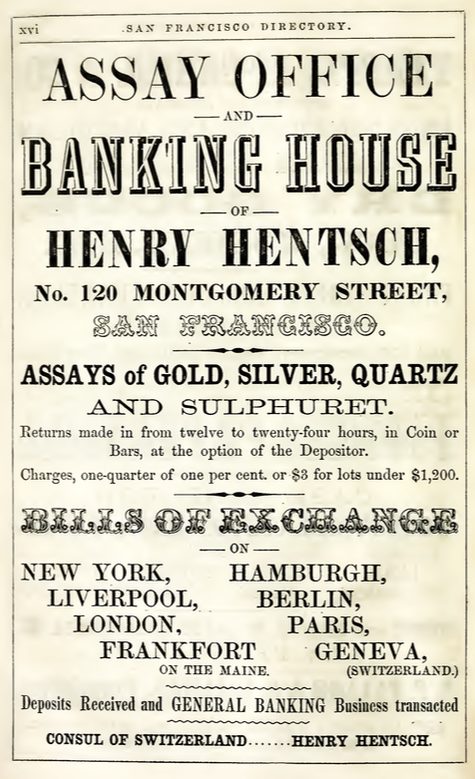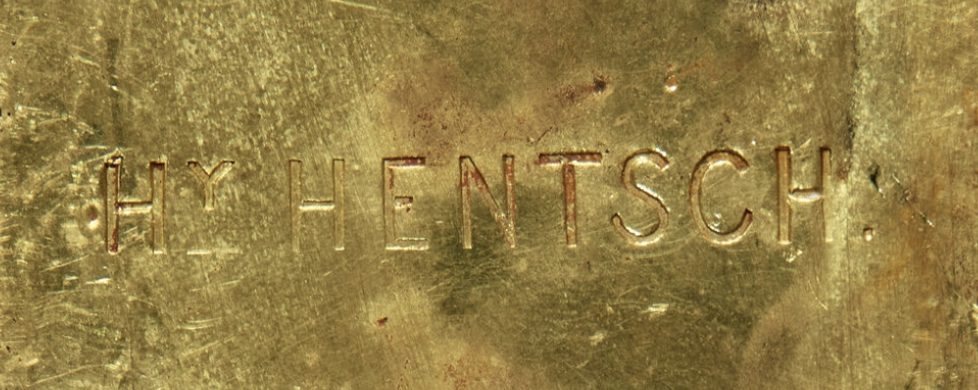In 1856, 21 year old Henry Hentsch set up banking office in San Francisco. In its February 2, 1856 edition, the Alta California announced:
“ASSAY OFFICE OF HENRY HENTSCH. Northwest corner of Montgomery and Jackson Streets. I have this day annexed to my Banking Establishment an Assay Office, and am prepared to carry on this business in all its branches. All orders confided to my care will be executed with promptness, and I will guarantee my assays. H. Hentsch. San Francisco.”
Hentsch listed sundry international references that included prominent banking firms such as Morris, Prevost & Co., London; Melly, Romilly & Co., Liverpool; Mathieu Hentsch & Co., Paris; and Hentsch & Co., Geneva, Switzerland. At the time, European banks were major destinations for California gold ingots and bars, and these international endorsements no doubt attracted depositors with such customers in mind. The Hentsch bars that were part of the S.S. Central America shipment were most likely bound for the Hentsch family banks in London, Paris, or Geneva. Although most of the ingots never made it to their final destination, amazingly one did. Benedict Hentsch participated in the Christie’s S.S. Central America Auction in December 2000 and acquired a Hentsch ingot for display in the Darier Hentsch Banks in Geneva, which have been in business since 1796.

Swiss born Henry Hentsch arrived in San Francisco on May 31, 1854 at the age of 35 years. He began his assaying activities shortly thereafter, and continued for many years, his firm eventually evolving into the San Francisco branch of the Swiss-American Bank. Hentsch relocated to Geneva, Switzerland between September 1867 and October 1868, according to contemporary city directories cited by Dan Owens. He remained in Geneva until his death in 1905. Until the discovery of the S.S. Central America treasure, Henry Hentsch was barely a footnote in California history. He never issued any private gold coinage, and there were no known ingots of his firm. His name is not mentioned, for example, in Don Kagin’s reference on private gold published in 1981, long before the treasure was located. Dave Bower’s suggested that many of Hentsch’s ingots may have been shipped to Geneva, given the businessman’s connections in that location. They would have been on board the Central America, being shipped to New York for transit to Europe. Even today, the Hentsch name is still associated with banking in Switzerland.
Henry Hentsch ingots are the rarest of all five assayers whose ingots sunk with the Central America, with only 38 such ingots discovered in the treasure. Serial numbers ranged from 3066 to 3244, thus it may be suggested that this ingot, with a serial number near the high end of that range, was produced closer to the time of the Central America disaster. Weights ranged from 12.52 ounces to 238.84 ounces.
S.S. Central America Ingots
38 Henry Hentsch gold ingots were recovered from the SSCA shipwreck. We may show an example of a particularly interesting example at a later date.

His logo used for an Assay stamp was not a particularly attractive hallmark. Simple and understated – simply his first name abbreviated by “Hy” followed by his last name in All caps: “HENTSCH”.
For a census of the known serial numbers, weights, and monetary values stamped refer to: https://finestknown.com/california-gold-rush-monetary-ingots/
